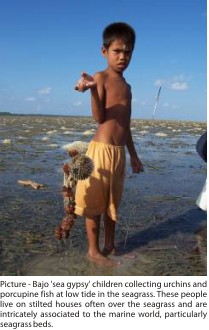Across the Asia-Pacific the general public and scientists are routinely bombarded by an increasing body of evidence documenting the sad and disastrous decline of coral reefs, but in all this furore are we as conservationists missing the full picture and forgetting other valuable habitats such as seagrass beds that may also be in danger? Seagrass beds are comprised of flowering plants that are more closely related to terrestrial lilies and gingers than to true grasses. They live entirely submersed in coastal marine waters and create habitats that can be 100's of kilometres in length, and contain a plethora of rich and diverse fauna. Despite the importance of seagrass beds in supplying ecosystem services such as nutrient cycling, critical nursery habitats, and food supply, there is growing evidence that they are experiencing an unprecedented level of damage, deterioration and overexploitation, mostly attributed to human activities. Degradation of seagrass beds has been commonly associated with man made problems such as nutrient run-off, sedimentation, physical degradation and pesticide leaching. However,in many areas of the world seagrass beds are increasingly threatened by another lesser-documented factor; over-exploitation of their productive fish and invertebrate assemblages.
The next time you are on holiday by the coast somewhere around the Indo-Pacific, wait for the full moon and go for a low tide stroll. Chances are that in many places you'll find seagrass beds, and amongst them countless fishers out collecting invertebrates, trapping fish stranded in tide pools, or bringing in their net laden with fish from when the tide went out. Much of this fishing is not large-scale commercial activity, it's mostly a subsistence activity, but also includes small family fishing collectives earning a basic livelihood selling excess catch.

This exploitation remains largely undocumented, but is thought to be increasing in areas of rapid human population growth. Although low intensity fishing may be of no risk to the environment, increasing intensity may alter the trophic structure of the habitat and cause the removal of particular slow developing species. Whilst many people are aware of coral reef fisheries as a key concern in tropical habitats, fisheries in other habitats are often forgotten about. Seagrass beds make ideal fishing grounds, they contain abundant fish and invertebrates whilst their location in shallow water means that they are readily accessible and that they can usually be exploited in all weather conditions. In contrast, reefs are often further from the shore making them less easily accessible during poor weather conditions, they are also more difficult habitats for net fishing due to the possibility of net snagging. Throughout many tropical regions, seagrass beds are commonly harvested at low tide for subsistence foodstuffs such as small molluscs, clams and urchins; and for commercial species such as octopus and sea cucumber. In some areas the seagrass itself can also be directly harvested as emergency foodstuffs, or as fodder for cattle and captured turtles. Due to their clear economic and ecological importance, and the fact that seagrass beds are becoming increasingly degraded, management of these habitats should increasingly be considered in local conservation efforts and as an economically vital habitat, particularly in areas where over-exploitation is widespread.
Conservation of seagrass beds has additional consequences for the coral reefs that are located adjacent to them. In the Wakatobi Marine National Park in SE Sulawesi, seagrass beds are coming under increasing pressure from hundreds of large tidal fishing nets (locally referred to as Sero) that are laid for up to 100 m across the seagrass and catch all fish moving with the tide.

Fish caught are often from families such as Emperor, Rabbitfish and Parrotfish that migrate between reef, mangrove and seagrass, and play important ecological roles on the reef. As well as the adult fish, large numbers of juvenile fish are caught, such as young Grouper, Snapper and Wrasse that utilise the abundant food sources within seagrass.
In a world of changing climate, exponential human population growth, mass extinctions and large scale habitat loss the ability of governments and conservation organisations to prioritise fisheries and conservation measures is an enormously difficult job. Seagrass beds are not an aesthetically pleasing habitat, they don't immediately stand out as colorful wonders of the world in magazines, newspapers or on wildlife documentaries, but they are undoubtedly an important economic and ecological resource, and they need to be conserved and managed for the future of the people who use them, and for the future of the biodiverse and colorful reefs that they are intricately associated with.